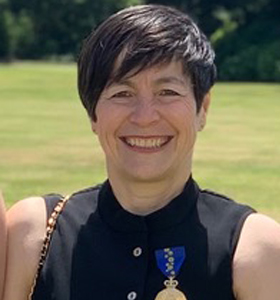This ABC News article profiles Mary Papanicolaou, and gives thanks to her decades of dedicated swabbing and sampling that she and her pathologist husband George developed the cervical cancer screening method we know today as the Papanicolaou or Pap test.
ABC NEWS ARTICLE
The next time you book yourself in for a cervical screen, spare a thought for the woman who endured a vaginal test every day for more than 20 years.
Her name was Mary Papanicolaou, and it’s thanks to her decades of dedicated swabbing and sampling that she and her pathologist husband George developed the cervical cancer screening method we know today as the Papanicolaou or Pap test.
“I think Mary’s contribution was obviously a key foundational contribution — equally, I would say, as important as George Papanicolaou’s contribution,” says Karen Canfell, director of the Daffodil Centre and chair of Cancer Council Australia’s Cancer Screening and Immunisation Committee.
“It has undoubtedly saved many, many millions of lives, and so I think we need to look back and understand … it was extraordinary.”
So how did the daughter of a colonel in the Greek army find herself the central figure in what would become one of the most successful cancer screening programs worldwide — and what is her legacy?
When Mary met George
Mary was born in 1890 into the Mavroyeni family — a military family from way back. Her great-grandmother fought to liberate Greece from the Ottoman Empire some 70 years before.
Indeed, Mary’s given name was Andromache, which means “a woman fighting alongside men” in Greek.
“Perhaps no other name could better champion her or her inner might,” diagnostic cytologist Nikolaos Chantziantoniou wrote in the Journal of the American Society of Cytopathology.
But as a girl, Andromache preferred to be called Mary, and her family spent summer holidays at a beach house — a short ferry trip from Athens — where they met and became friends with their neighbours, the Papanicolaou family.
When Mary was 20, she and George crossed paths again.
He’d just returned to Greece after his PhD studies in Germany, and found Mary to be “highly attractive, cultured, and educated”, according to Dr Chantziantoniou.
“George became infatuated with Mary, and his desire for her grew during the various engagement he attended as a guest in the Mavroyeni homestead in Athens,” he wrote.
They eloped, and after a short stint working as a zoologist, George was conscripted into the army during the Balkan War. When he returned in 1913, the couple emigrated to work and study in New York with only $250 to their name.
Neither spoke fluent English. Mary was the first to get a job, sewing buttons on clothes for a department store, while George sold rugs and did odd jobs, like playing violin at restaurants and cafes.
Eventually, though, George got his foot in the research door, and in 1914, he landed the position of assistant anatomist at Cornell Medical College.
A couple of months later, Mary joined him as a laboratory technician, but had to do so as a volunteer because Cornell had rules against paying spouses.
And so began a scientific endeavour that would change women’s health.
The original guinea pigs
The laboratory where the Papanicolaous worked was headed by anatomist and eugenicist Charles Stockard, who was investigating how alcohol damaged the chromosomes (and “quality”) of guinea pig offspring.
George led a project to explore if guinea pig sex was dictated by X and Y chromosomes.
To do this, he needed to get guinea pig eggs just before ovulation, but it was impossible to find out where a guinea pig was in its reproductive cycle without first killing it.
Knowing that guinea pigs menstruated, George wondered if fluids sampled from the vagina could signpost various points of the animals’ reproductive cycle.
Using a small speculum, he took tiny samples of guinea pig vaginal fluid daily, smearing them on slides and examining them under a microscope.
That cellular soup included cells sloughed from the surface (also known as the epithelium) of the cervix.
As the days and weeks passed, George noticed distinct patterns in the size and shape of epithelial cells present in the vaginal fluid, which he could precisely correlate to ovulation.
George and Charles published the work in 1917.
The next step, George reasoned, was to see if the same could be done in humans.
But he worked in a lab with guinea pigs, and wasn’t licensed to officially access human subjects.
So he turned to Mary.
On to human research
It heralded the beginning of Mary’s marathon 21-year contribution of daily tests.
She not only willingly donated vaginal fluid every day, but she also processed and stained her own samples in the lab to enhance parts of the cells, such as their nucleus, so they could be more easily examined.
It meant George was able to track the cellular changes throughout Mary’s life, from her reproductive years through menopause.
Mary eventually recruited friends to contribute vaginal fluid samples too, and a bigger trial began with women from the New York Women’s Hospital in 1925.
By this time, samples were collected by inserting a thin glass tube, which looked a bit like a skinny turkey baster, that sucked out a little fluid.
As George and his collaborator Herbert Traut wrote in their 1943 book, Diagnosis of Uterine Cancer by Vaginal Smears:
No instruments except the pipette are necessary. An intelligent woman can easily be taught to prepare her own smears when a large number of them is required for study.
Eventually, one of the volunteers developed cervical cancer.
Deborah Bateson, a professor of practice at the Daffodil Centre, says while “it was a terrible tragedy”, it also marked one of the Papanicolaous’s biggest developments.
“That was the massive breakthrough — showing that you could actually see these pre-cancerous changes as well in these cells.”
George presented the new diagnostic technique in 1928, but few gynaecologists and pathologists showed interest.
“George was obviously an incredibly forward-thinking scientist, but many people just thought, ‘this is nonsense,'” Professor Bateson said.
In fact, it took a decade for the medical field to start accepting that pre-cancerous changes in the cervix could be detected via something as simple as a smear of cells on a slide.
Convincing sceptics that the Papanicolaou test was valuable and effective would take another decade after that.
Cervical screening evolved
The Pap test as many people know it today it is a little different to what Mary did each day.
The modern-day method involves inserting a speculum to hold the walls of the vagina open and collecting cells from what’s called the transformation zone of the cervix, says Marion Saville, executive director at the Australian Centre for the Prevention of Cervical Cancer.
“That’s the area that’s vulnerable to virus getting in and causing changes that can lead to cancer.”
Australia introduced Pap tests in the 1960s, but it wasn’t until 1991 that the National Cervical Screening Program started offering free two-yearly Pap tests in sexually active women and people with a cervix, aged 20 to 69 years. It later included 18- and 19-year-olds.
Cervical cancer incidence and mortality has since halved.
Now a new type of cervical screening, which can be self-collected, is becoming standard.
It’s a little like the vaginal fluid sampling of 100 years ago, but instead of a thin glass turkey baster, the test now involves inserting a swab a few centimetres into the vagina, swirling it around for 20 to 30 seconds, and then popping it into a container.
If cells in the cervix have been infected with human papillomavirus (HPV), which can cause cervical cancer, the virus multiplies and its DNA is shed into the vagina.
So swabs are analysed for the presence of HPV DNA.
“Instead of looking for pre-cancerous cells, we’re looking for the virus that causes those pre-cancerous cells.
“That’s why we only need to screen people now every five years rather than, as we did in the past, every two years.”
It’s also more accurate and easier than the Pap test. It takes time and experience to be trained to recognise potentially problematic changes in Pap tests, whereas the new technique picks up the virus using an incredibly sensitive machine.
“So that really makes it easier to set up screening in places where previously it’s been very difficult,” Dr Smith says.
Mary’s lasting legacy
George and Mary continued working in the US until retiring in 1957 after more than 40 years working at Cornell (and for Mary, that was all unpaid).
George did gain some recognition for their work: he was nominated for the Nobel Prize in Physiology or Medicine at least 18 times.
In 1962, only a few months after taking directorship of the Cancer Research Institute of Miami, he died.
She continued to support cancer research until she died on October 13, 1982, at 92 years old.
For Professor Canfell, Mary’s contribution to cervical cancer prevention cannot be overstated.
“For a woman like me who’s working in the modern era in science, there may have been some difficulties, but nothing like what Mary confronted and what she sacrificed to have a career in science and to make this contribution at every level.
“She became a subject, she worked as a volunteer, she elected not to have children, and it was all to work in this partnership towards an outcome in health that is so important for women generally.”
Professor Bateson agrees.
“It was a tremendous act of great generosity, really.
“When I think about it, I’m in awe, and I’m grateful of that devotion that she gave to this advancement of science — this fantastic, well-educated woman, who perhaps wasn’t able to work to her full capacity because of the limitations and challenges at the time.”
Credits (photos and article): https://www.abc.net.au/news/health/2023-07-08/andromache-mary-papanicolaou-pap-smear-test-cervical-cancer/102484690

AFMW Treasurer / National Coordinator
Read Desiree’s ‘Herstory’

